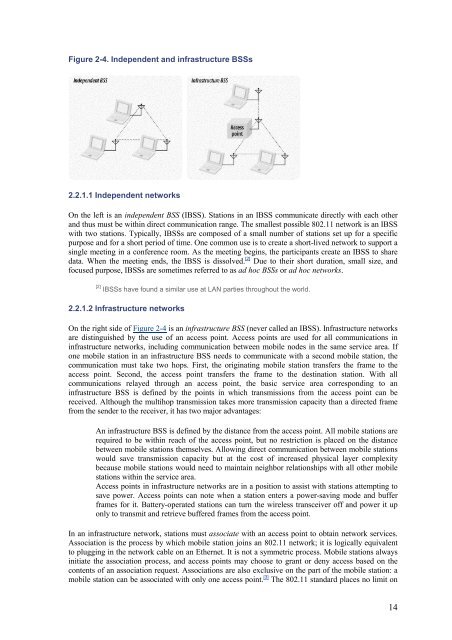Wireles Networks The Definitive Guide.pdf - Csbdu.in
Wireles Networks The Definitive Guide.pdf - Csbdu.in
Wireles Networks The Definitive Guide.pdf - Csbdu.in
Create successful ePaper yourself
Turn your PDF publications into a flip-book with our unique Google optimized e-Paper software.
Figure 2-4. Independent and <strong>in</strong>frastructure BSSs<br />
2.2.1.1 Independent networks<br />
On the left is an <strong>in</strong>dependent BSS (IBSS). Stations <strong>in</strong> an IBSS communicate directly with each other<br />
and thus must be with<strong>in</strong> direct communication range. <strong>The</strong> smallest possible 802.11 network is an IBSS<br />
with two stations. Typically, IBSSs are composed of a small number of stations set up for a specific<br />
purpose and for a short period of time. One common use is to create a short-lived network to support a<br />
s<strong>in</strong>gle meet<strong>in</strong>g <strong>in</strong> a conference room. As the meet<strong>in</strong>g beg<strong>in</strong>s, the participants create an IBSS to share<br />
data. When the meet<strong>in</strong>g ends, the IBSS is dissolved. [2] Due to their short duration, small size, and<br />
focused purpose, IBSSs are sometimes referred to as ad hoc BSSs or ad hoc networks.<br />
[2] IBSSs have found a similar use at LAN parties throughout the world.<br />
2.2.1.2 Infrastructure networks<br />
On the right side of Figure 2-4 is an <strong>in</strong>frastructure BSS (never called an IBSS). Infrastructure networks<br />
are dist<strong>in</strong>guished by the use of an access po<strong>in</strong>t. Access po<strong>in</strong>ts are used for all communications <strong>in</strong><br />
<strong>in</strong>frastructure networks, <strong>in</strong>clud<strong>in</strong>g communication between mobile nodes <strong>in</strong> the same service area. If<br />
one mobile station <strong>in</strong> an <strong>in</strong>frastructure BSS needs to communicate with a second mobile station, the<br />
communication must take two hops. First, the orig<strong>in</strong>at<strong>in</strong>g mobile station transfers the frame to the<br />
access po<strong>in</strong>t. Second, the access po<strong>in</strong>t transfers the frame to the dest<strong>in</strong>ation station. With all<br />
communications relayed through an access po<strong>in</strong>t, the basic service area correspond<strong>in</strong>g to an<br />
<strong>in</strong>frastructure BSS is def<strong>in</strong>ed by the po<strong>in</strong>ts <strong>in</strong> which transmissions from the access po<strong>in</strong>t can be<br />
received. Although the multihop transmission takes more transmission capacity than a directed frame<br />
from the sender to the receiver, it has two major advantages:<br />
• An <strong>in</strong>frastructure BSS is def<strong>in</strong>ed by the distance from the access po<strong>in</strong>t. All mobile stations are<br />
required to be with<strong>in</strong> reach of the access po<strong>in</strong>t, but no restriction is placed on the distance<br />
between mobile stations themselves. Allow<strong>in</strong>g direct communication between mobile stations<br />
would save transmission capacity but at the cost of <strong>in</strong>creased physical layer complexity<br />
because mobile stations would need to ma<strong>in</strong>ta<strong>in</strong> neighbor relationships with all other mobile<br />
stations with<strong>in</strong> the service area.<br />
• Access po<strong>in</strong>ts <strong>in</strong> <strong>in</strong>frastructure networks are <strong>in</strong> a position to assist with stations attempt<strong>in</strong>g to<br />
save power. Access po<strong>in</strong>ts can note when a station enters a power-sav<strong>in</strong>g mode and buffer<br />
frames for it. Battery-operated stations can turn the wireless transceiver off and power it up<br />
only to transmit and retrieve buffered frames from the access po<strong>in</strong>t.<br />
In an <strong>in</strong>frastructure network, stations must associate with an access po<strong>in</strong>t to obta<strong>in</strong> network services.<br />
Association is the process by which mobile station jo<strong>in</strong>s an 802.11 network; it is logically equivalent<br />
to plugg<strong>in</strong>g <strong>in</strong> the network cable on an Ethernet. It is not a symmetric process. Mobile stations always<br />
<strong>in</strong>itiate the association process, and access po<strong>in</strong>ts may choose to grant or deny access based on the<br />
contents of an association request. Associations are also exclusive on the part of the mobile station: a<br />
mobile station can be associated with only one access po<strong>in</strong>t. [3] <strong>The</strong> 802.11 standard places no limit on<br />
14















